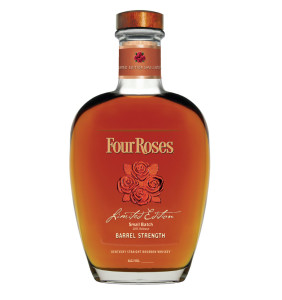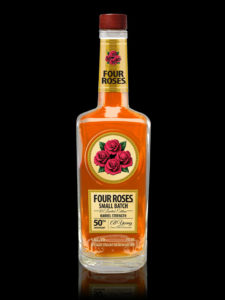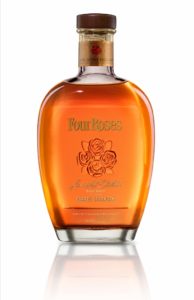The Four Roses Small Batch Limited Edition Round-Up
By Richard Thomas

(Credit: Kirin Brewing)
Almost a decade ago, Four Roses released the Mariage 2008, the first in a series of what would become known as the Small Batch Limited Edition (LE). Similar to the regular Four Roses Small Batch, these bourbons draw on individual stocks of the distillery’s famous 10 recipes. These ten variations stem from two separate mash bills, one a 35% high rye (B) and one a middling 20% rye (E), combined with five strains of yeast. These are described using four letter designations, such as the popular recipe OESK (mash bill E, yeast K).
Four recipes are used in the regular Small Batch, but the Limited Editions are more variable. The series began combining just two, with recent releases drawing on three or four. The whiskeys involved are older as well, mostly middle aged bourbons with some older stock thrown in. They are always bottled at cask strength.
The development of the series has gone in tandem with the rise of the Bourbon Boom. As time has gone by, production runs have risen to (unsuccessfully) keep up with demand, and prices have gone up as well. As Four Roses Distillery has attracted a substantial following of diehard fans, the Small Batch LE has become one of the most popular series of annual limited edition bourbons turned out each autumn, especially after the Four Roses Single Barrel LE went from annual to periodic.
This year will mark the tenth year of the series, making it as good a time as any to summarize Four Roses Small Batch LE:
Four Roses Mariage 2008: A blend of two different stocks of bourbon, one a 13 year old and the other a 10 year old. The recipes were not stated at the time, but the general assumption is that one was drawn from the high rye and the other the normal rye mash bill sets. The production run was 3,500 bottles at 112.4 proof, and at the time it could be bought for as little as $75!
Four Roses Mariage 2009: Following up on the first blended, limited edition release, Four Roses chose a batch of high rye (10 years old) and a batch of normal rye mash bill (19 years old) bourbons. Unfortunately, the release was not as well received by enthusiasts as the 2008 edition, with some describing it as too hot and/or tannic. It fetched a relatively moderate $80.

(Credit: Kirin)
Four Roses Small Batch 2010: This year saw the evolution from using two stocks of bourbon to three or more in making the limited edition release, thus the transition from Mariage to Small Batch. The blend was made with 15 year old OBSV, 11 year old OBSK and 10 year old OESK, and came in at 110.2 proof. Pricing held steady at $75, and it was well-received by enthusiasts.
Four Roses Small Batch 2011: Drawing on four stocks this time, the 2011 batch was made with 13 year OBSK, 13 year OESQ, 12 year OESV, and 11 year OESK. Reactions to this one were the most mixed yet, with some fans of the growing series thinking it was the hottest, spiciest installment yet, while others loved it. The price went up to $90.
Four Roses Small Batch 2012: Whereas most of the previous installments in the series had a run of 3,500 bottles, this one expanded to 4,000. This was also the first Small Batch LE that hit the same recipe twice, drawing from 17 and 11 year old OBSV, 12 year old OBSK, and a 12 year old OESK. This year was the best yet for the series, with many reviewers giving it top marks and some naming it their best bourbon of the year. The proof came out at 111.4 and the pricing fell to $70 a bottle.
Four Roses Small Batch 2013: Also known as the 125th Anniversary Small Batch, this one returned to using just three bourbons: 18 year OBSV, a 13 year OBSK and a 13 year OESK. The proof came out as the lowest yet, just 103.2 (floating just above the Bottled in Bond, 100 proof mark is odd for a cask strength). It was a huge hit, earning American Whiskey of the Year from Whisky Advocate. Adding to its luster was that it was just $85 at a time when prices for limited edition bourbons were rising and such things were becoming increasingly unobtainable. Part of that is down to the production run having been quite large, with over 12,000 made and 8,000 bottles distributed in the U.S.
Four Roses Small Batch 2014: They went back to drawing on four recipes for this release, with a drop in average age (based on straight numbers, not proportions) and a rise in strength. The result was a middling, average example of the series. It was made with OBSK 9 year old, OBSV 13 year old, OESV 12 year old and OBSF 11 year old, coming out at 111.8 proof. Production remained high, with the company turning out over 11,000 bottles at $90 a piece.
Four Roses Small Batch 2015: This one became the commemorative retirement release for veteran Four Roses Master Distiller Jim Rutledge, and was made with 16 year old OBSK, 15 and 14 year old OESK, and 11 year old OBSV, coming out at 107.7 proof. Official pricing hit three digits for the first time, at $119, this despite a 12,600 bottle run. Although not the blockbuster that 2013 was, it was very popular and got high marks from most reviewers who tried it.
Four Roses Small Batch 2016: The recipe this time around was based on a 12 year old OESO plus 12 year old OBSV and 16 year old OESK, coming out at 111.2 proof. The production run was 9,258 and the price rose to $129 a bottle, and as a rule those pricey bottles were almost as hard to get as the Buffalo Trace Antique Collection (BTAC) and Pappy van Winkle whiskeys. Yet reviews of this particular installment were quite mixed.

Four Roses Small Batch Al Young 50th Anniversary: Two small batch limited editions came out in 2017, and one of them was in a very 1950s/60s style bottle marking the 50th year for company veteran Al Young. The recipe here was 5% of a 23 year old OBSV recipe, 25% 15 year old OBSK, 50% 13 year old OESV and 20% 12 year old OBSF, coming out at 108.9 proof and in a 10,000 bottle production run. Pricing went up to $150. It was a good bourbon, but not seen as one of the stars of the series. However, it did mark the production run numbers starting to go up again.
Four Roses Small Batch 2017: Drawing on 20% 15 year old and 40% 13 year old OESK, plus the remainder in 12 year old OESV, this one came out at 107.9 proof and yielded a whopping 13,800 bottles. Pricing fell to $130, back down to approximately what the 2016 edition cost. It got high marks, with some calling it the best Four Roses Small Batch LE released since 2013.




What about the 2018? Hard to ignore that one.
I wrote this in January 2018, before that was released.